2022 SESLHD Healthcare Awards Ceremony
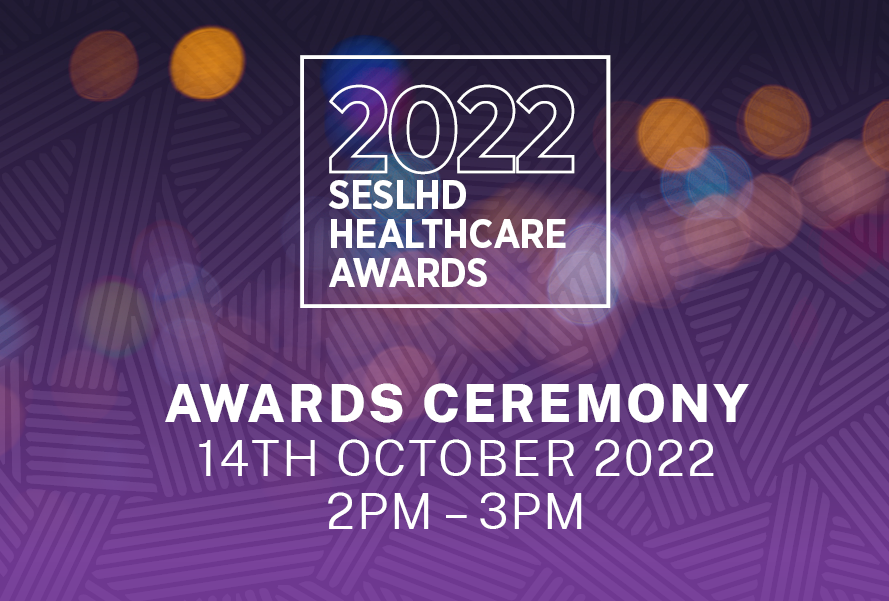
All SESLHD staff are invited to attend the 2022 SESLHD Healthcare Awards Ceremony via a livestream available here.
Award nominees and their guests are invited to attend the ceremony in person at a live event hosted at various facilities around the District.
2022 SESLHD Healthcare Awards
Winner
Sustaining and embedding the NSW Statewide Telestroke Service as part of a Supra LHD, Hosted at POWH, SESLHD – POWH
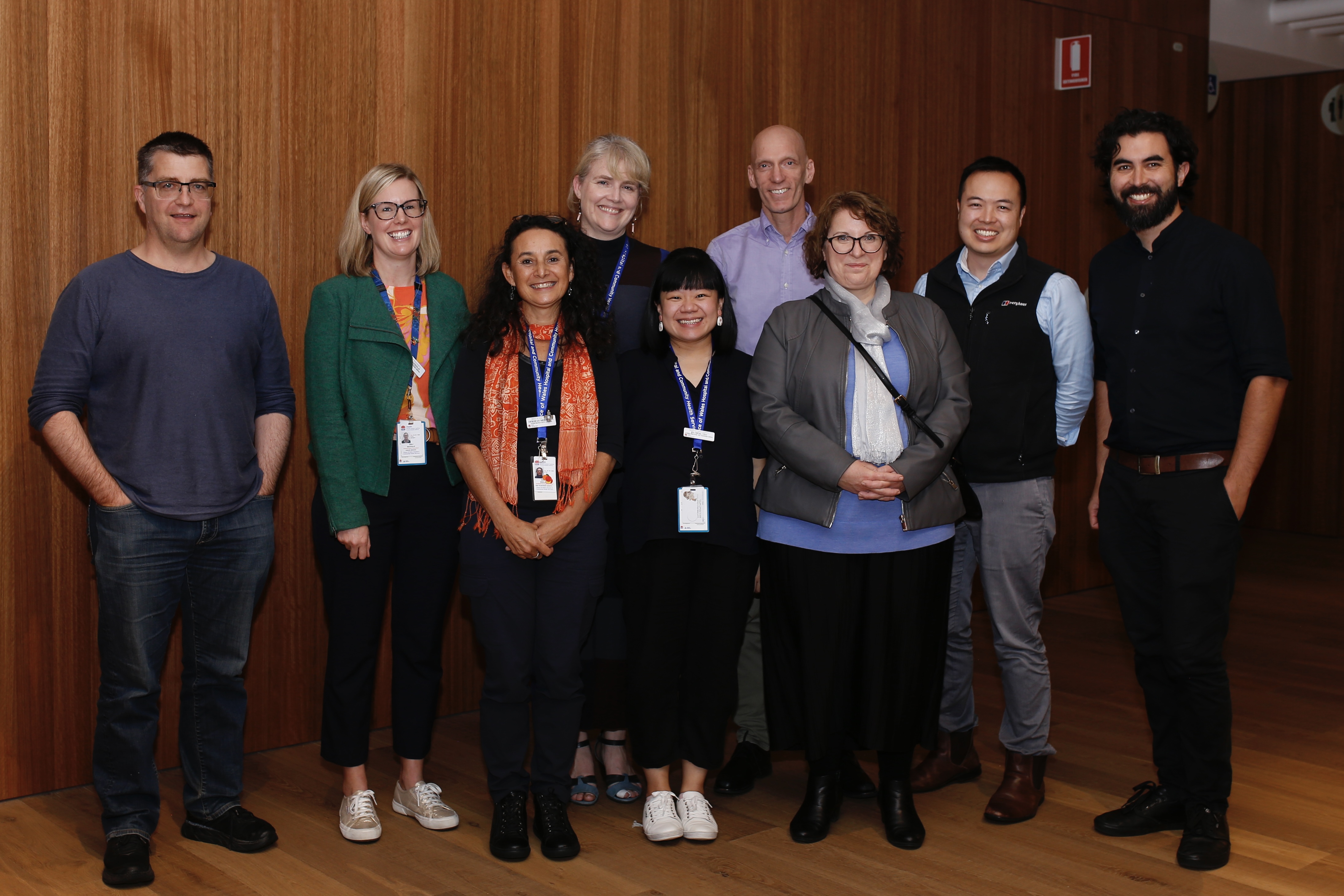
The NSW Telestroke Service (NSW TSS) is a Statewide 24/7 hyper-acute stroke service providing time critical care to patients of regional and remote NSW. The aim of the service is to save lives and reduce the disability from stroke.
NSW TSS is a Virtual Hub and Spoke model hosted and operationalised from Prince of Wales Hospital, SESLHD. The NSW TSS implementation was a collaboration between the Ministry of Health, SESLHD, the Agency for Clinical Innovation and eHealth with a staggered role out.
NSW TSS connects 23 regional and remote hospitals, from 9 local health districts with a stroke Specialist Neurologist via video conferencing technology enabled on the Workstations On Wheels. Advanced brain imaging with CT perfusion has been optimised to facilitate on site assessment, diagnosis and reperfusion therapies closer to patient’s homes. This integrated model of care ensures equity of access to best practice stroke care to patients. The NSW TSS continues to enhance the rural health workforce through training, development and support.
The NSW TSS offers a sustainable integrated model of care incorporating patient and clinician education, and provision of high-quality care with Statewide policy development. Through comprehensive data collection, patient outcomes are evaluated, and ongoing quality improvement activities are facilitated.
-------------------------------------------------------------------------------------------------------------------------------------------------------
Early Identification of Leisure Needs during Admission – Supporting a Person to Transition to Residential Aged Care – Garrawarra
The admission process and transition into a residential aged care facility (RACF) can be a stressful and anxious experience for the individual and families. Garrawarra Centre identified that an early referral to the Diversional Therapy team during the admission phase could alleviate concerns and support a smooth transition for the resident into care. Diversional Therapists were linked in with new residents, their families and previous RACF or hospitals during pre-admission to establish person centred leisure interests and needs. An interim Diversional Therapy care plan and leisure profile was created and communicated with staff on admission. This information assisted staff to understand ‘who’ the person is, their life experiences, leisure preferences, cultural and religious beliefs, enabling the development of therapeutic rapport and strategies to support the person to settle into their new home. The early identification of resident leisure needs during the admission period has also had a positive impact on the transition and development of trusting relationships for new residents and their families with the staff at Garrawarra Centre. Families have reported a sense of collaboration and inclusion in sharing the history of their loved one and developing a care plan that is meaningful and respectful of the biopsychosocial history of the person entering care.
Integrated Care Chronic Diseases Working Party - STG
The Integrated Care - Chronic Diseases Working Party at St George Hospital was established in 2017 to help support the development of improved communication between General Practice and St. George and Sutherland Hospital clinicians. We are a unique group consisting of representatives from the hospital including staff specialists, chronic disease clinical nurse consultants, IT, pharmacy and community representatives from the primary health network, general practitioners and health pathways. We meet bi-monthly to discuss initiatives and raise areas of concern that can be explored to improve the relationships with tertiary and primary care. We have executive sponsorship from the division of medicine nurse manager and the division of medicine medical lead.
SES HealthPathways - ensuring GPs have access to the right information to help patients – PaCH
HealthPathways is a website for GPs with local, up to date, clinical and referral information.
The benefits of pathways are that they assist GPs to work to the extent of their scope of practice, saving the hospital system for those that truly need it.
South Eastern Sydney HealthPathways (SESHP) is one of the younger NSW programs. At the start of the pandemic there were key clinical areas where pathways had not yet been developed, due to maturity.
To overcome this, the SESHP team diagnosed which pathways GPs would need during the course of the pandemic and set out to ensure all possible pathways were available in-case the hospital system needed increased support from Primary Care.
Since January 2020, the team have specifically developed pathways covering COVID-19, Mental Health, Palliative Care and Respiratory to ensure SESHP provided adequate support for local GPs. During this time the team delivered over 290 pathways.
Winner
Supporting Aboriginal communities through COVID - Public Health Unit
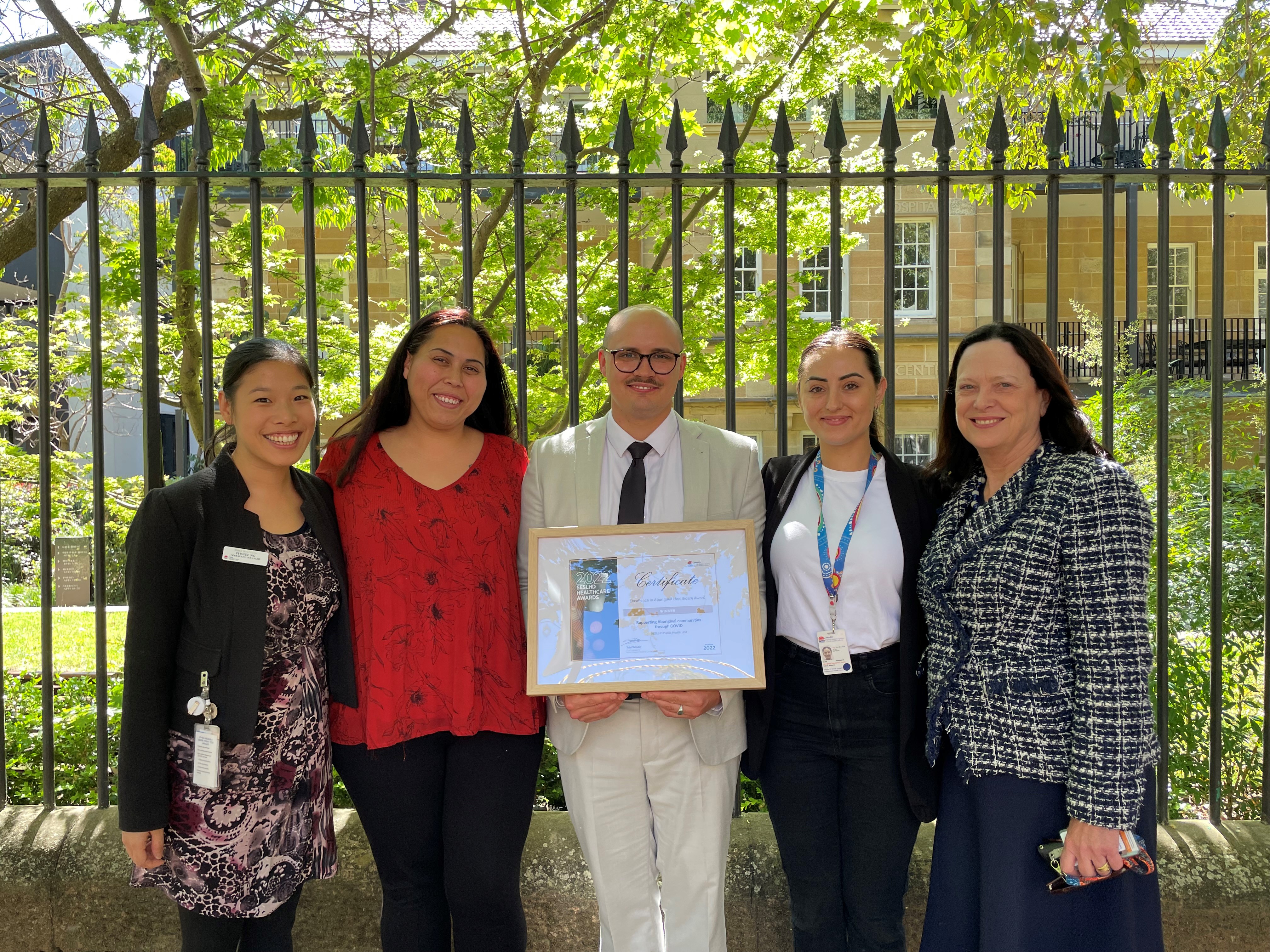
During a pandemic, Aboriginal and Torres Strait Islander people are considered an ‘at risk’ population due to their higher risk of severe disease compared to non-Aboriginal people.
To support the Aboriginal community through the pandemic, the PHU worked with the Aboriginal Health Unit to implement a number of strategies and new models of care aimed at supporting the needs of Aboriginal families and communities. This included:
- Establishing an Aboriginal Support Officer (ASO) service which provides important up-to-date information to the community, cultural support for cases and close contacts, answer questions and address concerns of the Aboriginal community. This included a website and dedicated support phone line, linking clients with social work, welfare support, mental health support and information on how to connect to local Aboriginal and Torres Strait Islander services via videoconferencing or telehealth.
- Running dedicated COVID and influenza vaccination clinics for Aboriginal people in collaboration with SESLHD Aboriginal Health Unit, Aboriginal Health Workers (AHW) across the District, La Perouse Aboriginal Lands Councils, local businesses, SESLHD and Sydney Children’s Hospital vaccination hubs. 1,391 people were vaccinated across 21 clinics.
- Helping La Perouse Community Health Centre to establish a COVID testing service for their Aboriginal communities through training and supply of rapid antigen test kits.
Winner
Slide into headspace: Demand Management Strategy - MHS
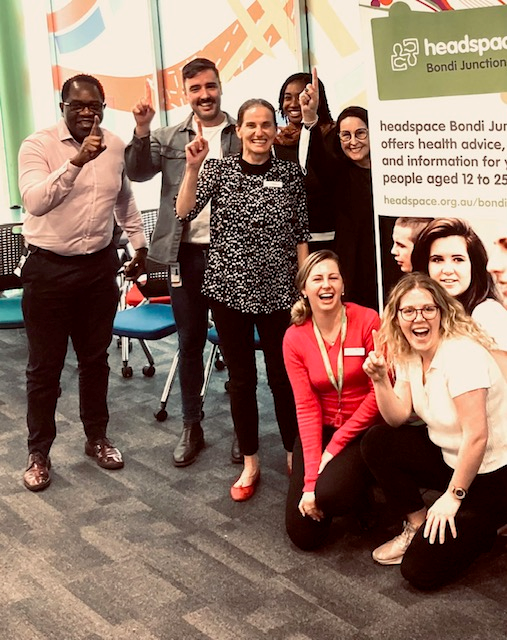
Slide into headspace: Demand Management Strategy is a clinical redesign project grounded in innovation and co-design to address issues contributing to long wait times at headspace Bondi Junction.
Since headspace Bondi Junction’s inception in 2016, increased demand for services have been experienced year-on-year. Service data showed a 50% increase on the average monthly intake data from 2016 to 2019 prior to the COVID pandemic, continuing over the months the state was not in lockdown during 2020 and 2021. The increased demand for services has led to longer waiting times for young people aged 12-25 seeking access to mental health support.
Specifically, the project has three main objectives to achieve by 30 June 2022:
- Decrease wait times at three points of care (intake triage, initial assessment and psychological treatment);
- Reduce the percentage of young people reporting ‘waiting too long’; and
- Increase percentage scores on Your Experience of Service (YES) survey in ‘participation’ and ‘impact’ domains.
Preliminary results demonstrate that in the first year, the project has achieved:
- The time from initial point of referral to access to care reduced from 8 days to 4 days;
- The time from intake/triage to assessment/treatment planning reduced from 28 days to 8 days;
- The number of young people reporting “waiting too long” reduced from 80% to 32%; and
- The wait for psychological treatment sessions under the Better Access Funding Scheme reduced from 3 months to 1 month.
Winner
AKI e-alerts reduce hospital length of stay – POWH
BACKGROUND Early recognition of hospital-acquired acute kidney injury (AKI) may improve patient management and outcomes.
METHODS This multicentre study was conducted at three hospitals (Hl- intervention; H2 and H3-controls). The intervention bundle [an interruptive automated alerts (aAlerts) showing AKI stage and baseline creatinine in the eMR, a management guide and junior medical staff education] was implemented only at Hl. Outcome variables included length-of-stay (LOS).
RESULTS Over 6 months, 639 were studies; 537 (84%) patients developed Stage 1, 58 (9%) Stage 2 and 43 (7%) Stage 3 AKI. Patients with AKI stage 1 had shorter LOS at Hl [median 8 versus 10 days (P = 0.021)]. Most patients had community acquired AKI. Documentation of AKI was better in Hl (94.8% versus 83.4%; P = 0.001), with higher rates of nephrology consultation (25% versus 19%; P = 0.04) and cessation of nephrotoxins (25.3 versus 18.8%; P= 0.045).
CONCLUSIONS Most patients developed Stage 1 AKI (community acquired) and remained outside the intensive care unit (ICU). The AKI eAlert bundle reduced LOS in most patients with AKI and increased AKI documentation, nephrology consultation rate and cessation of nephrotoxic medications and has savings in bed days for the hospital.
-------------------------------------------------------------------------------------------------------------------------------------------------------
Looking towards the Future in Eye Microsurgery – SSEH
Through collaboration with the Sydney Eye Hospital Foundation, ophthalmologists, executive and the provider, the ophthalmology department at Sydney and Sydney Eye Hospital achieved their goal to obtain the latest innovative technology in ophthalmic microsurgery, the industry’s first digital operating microscope in Australia, and use this technology to embed the much needed enhanced surgical virtual care model.
The technology has provided opportunities for ophthalmologists to collaborate with team members and experts in the operating room and remotely leading to achievement of the best possible patient outcomes as well as innovative development of teaching and collaboration opportunities for staff.
In addition the technology has fostered a culture of continuing innovation and translation within the ophthalmic team. The 3 -dimensional camera allows for shared simultaneous viewing of the surgical field allowing all members of the surgical operating team, including virtually to remote locations. Patient care and surgery is allows more interactive involvement with potential benefits this advanced model of care can provide.
A novel functional rehabilitation facility "The Circuit" – TSH
The rehabilitation ward had limited facilities to practice everyday skills such as walking across an uneven driveway or putting groceries in a car boot. Outdoor mobility training was previously inefficiently conducted 1:1 with limited intensity due to therapist supervision limitations (average 7.2minutes/session), on hospital grounds with no emergency response system. Only 21% of previously community ambulant patients received outdoor mobility training prior to discharge, with half of these patients walking less at 2 weeks post-discharge than preadmission.
Evidence suggests that an enriched environment in stroke rehabilitation increases motor, cognitive and sensory stimulation and increases feelings of personal control. ‘The Circuit’, a purpose-built training facility, was designed and constructed to incorporate both physical and cognitive challenges that reflect real-life situations. Therapy is able to be conducted in a semi-supervised group format, increasing the intensity of practice completed. Staff have reported the facility is ‘empowering’ as they are able to provide meaningful care, and positively contributes to their job satisfaction.
‘The Circuit’ is an evidence-based rehabilitation tool that we anticipate will improve patient confidence and functional outcomes, and reduce reliance on follow-up services. We are changing the way therapy is delivered; ‘The Circuit’ is patient-centred and pioneering in the area of rehabilitation.
The SESLHD Population and Community Health Dashboard – PaCH
AIM: The Community Health Information Management Unit (CHIMU) sought to develop a Population and Community Health (PaCH) dashboard for staff to summarise and visualise their client and service activity data in an accessible and impactful way.
METHOD: CHIMU informatics staff developed an initial beta version of the dashboard using de-identified client level data (including demographics and occasions of service) extracted from the electronic medical record (eMR) via the Enterprise Data Warehouse (EDW) and refreshed thrice weekly. ‘Real-time’ views of client and service activity data were displayed via QlikSense. After testing and input from senior managers and clinicians, extra sections were added to assist service delivery and planning. Ongoing user feedback was invited regarding dashboard functionality.
RESULTS: The PaCH dashboard is the most utilised in SESLHD (figure 1). Managers and clinicians report the dashboard makes their day-to-day work easier by providing quick self-service access to at-a-glance summaries of large volumes of service data which they can act upon as needed. Ongoing user feedback has informed dashboard evolution and updates.
CONCLUSION: The PaCH dashboard assists service delivery and planning by enabling staff to quickly and easily summarise and visualise client and service activity data and act as required.
Use of Innovative Shielding System to Lower Radiation and Covid-19 Transmission – STG
AIM: To see if lead gown free procedures could be possible and the use of lead shields prevent the transmission of Covid-19.
WHY: To alleviate both the radiation and orthopaedic issues in the Cardiac Catheter Lab (CCL), we trialled an innovative shielding system (RampartTM) which surrounds the patient’s torso with lead equivalent acrylic shielding. We used its wall of Perspex as a possible COVID shield with adaptions
METHOD: We used Polymaster tm Radiation monitors to measure operator scatter dose both under and over the lead gowns. We measured without the Rampart shield, and with the Rampart shielding system to determine effective % Radiation attenuation to the operator in a real world setting for both shielding scenarios
RESULTS: Whilst the desired equivalency with normal lead gown protection was shown, the stand out readings where the increased protection to operators whole head and face.
CONCLUSIONS: Current radiation protection comes at orthopaedic cost.
We trailed a new ( non gown ) operator shielding system, and measured both scenarios radiation attenuation %
We found equivalent body protection, and a high level of new head, arms and hands protection. An important point is that this effectiveness is reliant on correct shielding positioning and use of real time audible alarm radiation monitors would be advised
This is project could change the way the CCL is run in the future and prevent injury to the staff members.
ECG Integration with eMR POWH/SSEH – POWH
Following a number of Root Cause Analyses (RCAs) ECGs at POWH were integrated with eMR in the Emergency Department, with paper ECG’s remaining across the rest of the Hospital, creating a Hybrid record (Paper and electronic). Following a Coroner’s recommendation, POWH and SSEH commenced a project to integrate all ECGs performed across the hospitals with the eMR.
POWH/SSEH established a project steering committee comprising of Clinical Engineering, Health ICT, Health Records, with front line clinical staff and executive sponsorship to define the clinical, technical and medical records requirements. The key requirements included the solution needed to be scalable, not lock the hospitals into a single vendor, and match the ideal clinical workflow minimising the clinical practice changes required.
After performing a market assessment and following procurement process, the preferred vendor was selected. This step included reviewing the technical requirements of the carts, assessing the current state of ECG devices and practices across the hospitals, identifying POWH had 59 ECG carts which we were able to rationalise down to 34 but increasing the utilisation of the ECG capability in the patient monitoring system.
The project team worked to establish an agreed integrated workflow for ECGs that was scalable across the district, multi-vendor and sustainable. The solution allows for the electronic review of ECGs and generates alerts in eMR if a patient’s ECG has not been reviewed.
In the 9 months following implementation, POWH had performed 24,000 ECGs all electronically captured, with review status tracked.
A Youth Brief Intervention Service for Youth in Crisis (yBIS)
During the COVID-19 pandemic, young people started presenting to mental health services in greater numbers with higher levels of psychological distress and acuity, greater clinical complexity, and with reduced capacity in their support networks. Increased demand for services often meant a delay in accessing care. Through COVID enhancement funding, the Youth Brief Intervention Service (yBIS) was developed and implemented from June 2021 in the Eastern Suburbs Mental Health Service (ESMHS). yBIS is offered to young people aged 12-25 years who present to ESMHS in suicidal and/or self-harm crisis. Participants and their carers are offered the intervention face-to-face or virtually by the yBIS multidisciplinary team and peer worker, over a three to four-week period. The aim is to provide timely evidence-based care to reduce distress, develop a safety plan, and connect with appropriate services beyond the intervention. Preliminary data suggests that yBIS is a feasible and effective service for young people in crisis. There is potential for yBIS to be scaled up pending the results of the service evaluation as one response to the current crisis in youth mental health presentations.
Winner
Regulating e-cigarettes in the LHD – PaCH
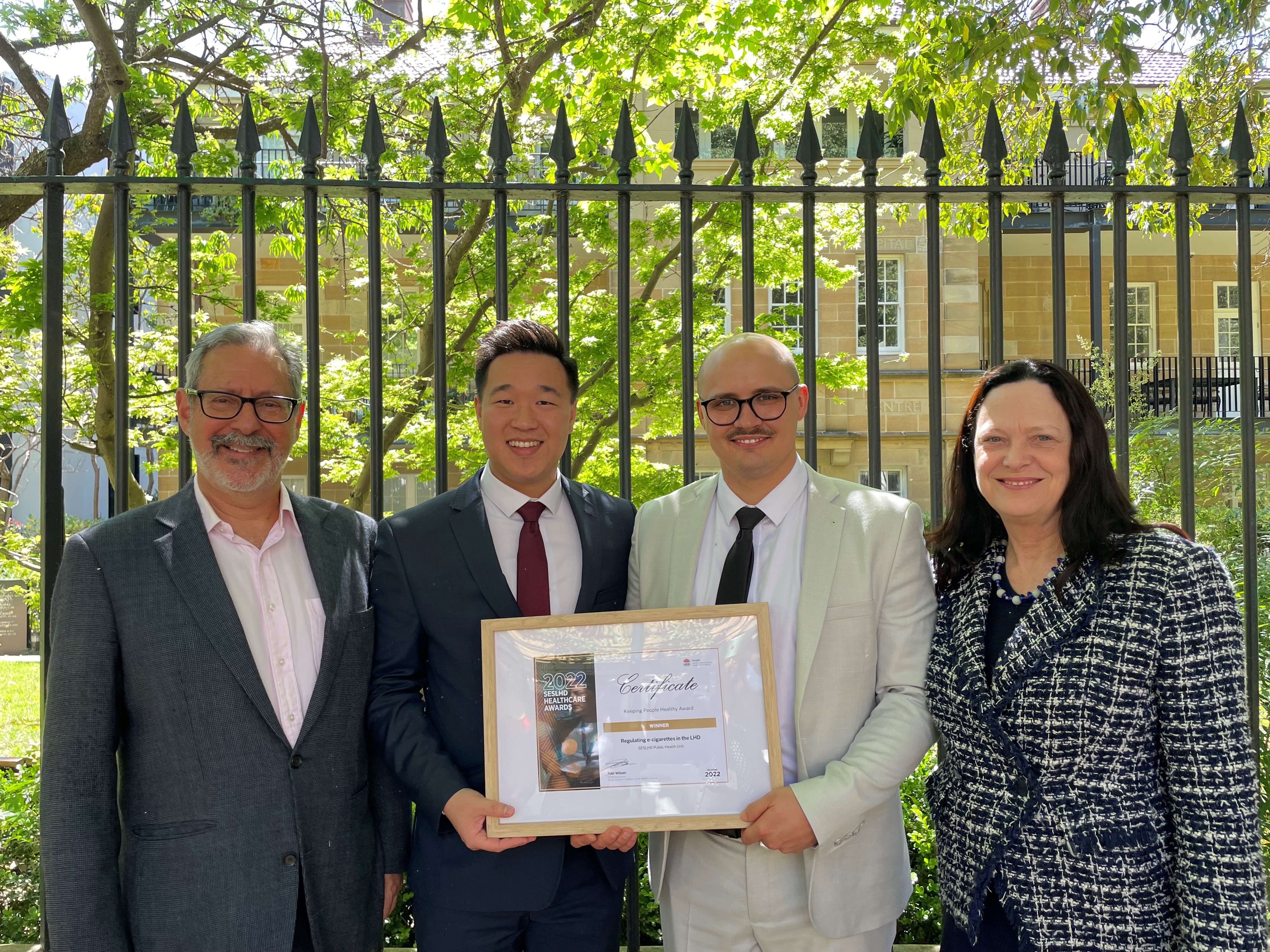
Evidence clearly shows e-cigarettes are increasingly marketed to appeal to children and young people. E-cigarettes can provide a gateway to a lifetime of nicotine addiction and dependency. This is emerging as a public health issue across the world.
SESPHU have proactively responded to this issue which has included:
- 32 seizures of e-cigarettes containing nicotine from tobacco retailers to the street value of $616,291
- 4 successful prosecutions for supplying a schedule 7 substance (liquid nicotine) without authority
- 25 penalty infringement notices issued to tobacco retailers for allowing e-cigarette products to be visible to the public
- 49 vape cartridges submitted to the Government Analyst for analysis with 41 found to contain nicotine
- Joint operations with NSW Police and Ministry of Health
- 1 project undertaking covert purchases of e-cigarettes from 18 tobacco retailers in suburbs near Aboriginal communities. Following the compliance test, seizures were undertaken in 6 tobacco retailers who sold e-cigarettes containing nicotine.
Investigation of the e-cigarette used by the first diagnosed case of EVALI in Australia whereby the vape seller was prosecuted and fined $4,500. A report on the case and response was accepted and published in the Medical Journal of Australia, 2021.
-------------------------------------------------------------------------------------------------------------------------------------------------------
The Maroubra COVID-19 Vaccination Clinic for People Living with Mental Illness – MHS
People living with a severe mental illness experience significant barriers in accessing primary health services such as poverty, increased disorganization, and a lack of primary health services familiar with providing care to people with a severe mental illness.
The recently published Global Call to Action Fair and equitable access to vaccination for people living with mental illness highlights that for vaccine preventable conditions, people living with a mental illness have almost 5 times the rate of being hospitalised, 4 times the rate of premature death from, have over 7 times the rate of preventable hospital bed days, and that proactively offering vaccination to people with serious mental illness would save Australia $84 million in hospital costs yearly.
The Eastern Suburbs Mental Health Service partnered with the Kirketon Road Clinic, PaCH to obtain COVID-19 vaccines and set up a tailor-made vaccination clinic at The Maroubra Community Mental Health Centre.
As of 13 March 2022, the clinic had ensured that 85% of adult mental health service users living with severe mental health conditions in the Eastern Suburbs Mental Health Service catchment had received two doses of COVID-19 vaccines, and 55% had received 3 doses – a rate higher than the demographically matched general population.
Caring for our vulnerable, COVID in Aged Care Facilities – TSH
AIM: Containment of a cluster of COVID-19 positive residents to mitigate risk of death and severe illness within a residential aged care facility (RACF), with an innovative use of a Rapid response aged care outreach service process by The Sutherland Hospital Geriatric Flying Squad (GFS)
RESULTS: The outbreak in this RACF lasted 6 weeks. A total of 12 COVID-19 positive residents with mild to severe disease were managed within the RACF during this period. Two residents died while on a pre-existing palliative care pathway. The other 10 residents completely recovered.
Conversely, The first resident (excluded from the 12 above) who tested COVID-19 positive and was transferred to hospital with mild symptoms, deteriorated during a three-week admission and received palliative care. He died two days after discharge to RACF.
CONCLUSION: GFS provided safe management of this cluster of COVID-19 positive residents. Availability of this unique service supported the care preferences of family members and due to the presence of advanced dementia in these residents they had potential for worse outcomes in hospital as opposed to their usual place of care particularly in the setting of COVID-19 infection 7. Improving health outcomes for this high risk aged care group was our driver.
Prevent Alcohol and Risk Related Trauma in Youth, (P.A.R.T.Y.) – STG
The Prevent Alcohol and Risk Related Trauma in Youth, (P.A.R.T.Y.) Program is a dynamic, interactive health promotion Program aimed at youth and promotes injury prevention through reality education.
It enables youth to recognise and minimise risks, and make informed choices about risk-taking behaviour and activities. The program is offered to school students in year 10, aged 14 years and above.
The program was established and delivered in St George Hospital Education Centre, Emergency and ICU in 2016, however, COVID-19 and the associated restrictions on education and hospital visits halted the implementation of the P.A.R.T.Y. programme within SESLHD in 2020.
The SESLHD CNC Trauma & P.A.R.T.Y developed an innovative way to deliver the P.A.R.T.Y programme on school sites, whilst maintaining the clinical and environmental impact of the program.
This was achieved via creativity and innovative use of resources and educational tools, partnership and collaboration between SESLHD clinical staff, Institute of Trauma and Injury Management (ITIM), emergency services (police and ambulance), trauma survivors and high school teaching and wellbeing staff.
To recreate the simulation scene, arguably the most impactful part of the education program, the SESLHD CNC Trauma & P.A.R.T.Y applied for funding to build an inflatable simulation resus room. ITIM, a network within the Agency for Clinical Innovation, funded the inflatable simulation room and set up of the revised program ($10,300). The pop-up inflatable room becomes the emergency department resus room, where doctors, nurses and paramedics act out the simulation in the school.
Winner
Improving intrapartum care to reduce neonatal hypoxia
BACKGROUND Hypoxic ischaemic Encephalopathy (HIE) occurs when a baby does not receive adequate oxygen or blood flow to the brain around the time of birth. From November 2019 through to September 2020, nine babies were born with HIE at RHW. Eight of the cases involved inadequate recognition on the cardiotocograph (CTG) with a subsequent failure to escalate care.
AIM To improve safety and effectively reduce the number of preventable neonatal HIE cases.
METHODS A purpose built RHW audit tool was designed to assess compliance with NSW Health Guideline GL2018_025: 'Fetal heart rate monitoring'. This guideline assists clinicians to identify early signs of intrapartum fetal hypoxia on CTG in order for timely intervention to occur for women and their unborn babies.
ANALYSIS A retrospective audit of clinical records was conducted using the RHW audit tool. Data was collated and tracked and graphically represented
INTERVENTIONS
- 100% staff compliance with fetal safety education and HETI 'Fetal Safety' modules.
- Multidisciplinary education of GL2018_025.
- Retrospective clinical audit using RHW tool of all births requiring CTG tracing.
AUDIT RESULTS
- 5 minutely annotation on CTG traces increased from 7.5% to 86%
- Hourly double signatures on CTG stickers increased from 56% to 96%
- 100% completion of clinical documentation with clinical situation, action taken and a management plan
- 100% midwifery completion of mandatory maternal and fetal safety modules on My Health Learning.
- Timing of escalation in delayed second stage improved from 38% to median 92%
- No preventable neonatal HIE cases occurred since commencement of the patient safety initiative. During the previous 12 months 89% (n=9) of cases were assessed as potentially preventable.
-------------------------------------------------------------------------------------------------------------------------------------------------------
SSEH Reduction in Hospital Acquired Complications - One is too many – SSEH
In 2018-2019, Sydney/Sydney Eye Hospital (SSEH) had 44.0 hospital acquired complications (HAC) per 10,000 cases, compared to the state average of 259.2 per 10,000 cases. A series of projects in 2020 and 2021 were implemented and led by the SSEH Executive to further reduce the number of HACs, in particular those linked to endocrine, cardiac, falls and delirium. Through this whole of hospital work, the service reduced their HACs by 46% to 26.2 per 10,000 cases compared to the state average of 248.4 in 2020-2021 financial year.
The hospital implemented the National Comprehensive Care Standard and utilised the Australian Commission on Safety and Quality in Health Care, Hospital Acquired Complications Toolkit and as well as other evidence based initiatives including:
Endocrine Incidents: Creation of new diabetes nursing roles, extensive education resource development and delivery through different mediums.
Cardiac Incidents: Implementation of ACI pathway, nurse led clinical reviews, updates to Acute Chest Pain management to incorporate the Acute Coronary Syndrome Pathway.
Falls Incident: Upgrade of equipment, implementation of the Leading Better Value Care program for Falls Prevention.
Delirium Incidents: Implementation of a nursing specific model of care, incorporating early referral to general medicine Clinical Nurse Consultant and the use of the Sunflower Tool.
Improving the experience of care for vulnerable patients (VP) at TSH
Three vulnerable patient (VP) deaths occurred over a 3 year period at the Sutherland Hospital (TSH). The aim of this project was to improve identification of our vulnerable patients, risk management of them, and implement Governance processes to ensure their safety.
Strategies implemented include
- establishment of a governance structure
- improved identification and communication of admission of vulnerable patients (VP)
- Introduction of a multi-disciplinary team (MDT) pre-admission and post 24 hour’s admission meeting for VP’s.
- expansion of the weekly TSH patient huddle to include current and planned VP admissions,
- adding newly admitted VPs to the afterhours shift report and daily safety huddle
- adding a VP alert in the medical record.
Since implementation of a clinical business rule (December ’21) there has been;
- zero serious incidents reported involving VPs
- positive feedback received from families of a coordinated
- approach to care for their vulnerable loved one
- Increased awareness amongst staff of the need to plan, communicate to families and make reasonable adjustments for VPs to improve their experience of care.
This Quality improvement focus at TSH has ensured safer care of this vulnerable group.
Improving the management of patients who deteriorate after hours – TSH
Three serious incidents occurred during 2021, all included a failure to escalate clinical deterioration to senior clinicians which contributed to poor patient outcomes.
Solutions developed and implemented by the multidisciplinary working party included the introduction of an afterhours (AH) Clinical Emergency Response (CER) Clinical Nurse Consultant (CNC) from 12pm to 12am, 7 days a week; processes to support early and transparent communication about patient deterioration to senior managers, clinicians and families and guidelines updated to include parameters when the surgical registrar must escalate to the Medical Officer In Charge following rapid response calls.
Patients and staff have benefitted significantly by being supported by a senior nurse with clinical expertise in recognising and responding to patient deterioration. Patient safety has increased as a result of improvements in timely decision making and documentation of patient management plans. Since the AH CERs CNC commenced in December 2021 there have been zero deaths from failure to escalate patient deterioration.
Strategies implemented has resulted in improved communication between clinicians and managers and increased confidence of clinical staff in managing patient deterioration. The addition of the After-hours CERS CNC is a valuable resource that has enabled an innovative approach to improving patient safety.
POWH HAI Strategy 2019-2021 – POWH
In 2018, the Australian Commission on Safety and Quality in Health Care (the Commission) developed a national initiative aimed at reducing Hospital-Acquired Complications or HAC's. A HAC refers to a patient complication for which clinical risk mitigation strategies may reduce (but not necessarily eliminate) the risk of that complication occurring. HAC's are a problem for patients and their families as they affect the patient's recovery, overall outcome and can result in a longer length of stay in hospital. HAC's are also a concern for hospitals as patient's admission costs more if they experience a HAC, diverting resources away from other patient care activities.
Triangulation of data from a variety of sources including, surveillance data, incident data, RCA reports, clinical practice audits, hand hygiene audits and benchmarked Hospital Acquired Complication (HAC) reports as well as Executive Leadership walkarounds identified evidence of a hospital acquired infection problem at POWH.
In July 2019, an executive led workshop was held with key clinicians and managers with the aim of formulating a hospital wide plan to reduce this key patient safety risk.
This workshop identified 6 areas for opportunity to improve the outcome for patients being at risk of developing a HAI during their admission at POWH.
Implementation of a Multi-Disciplinary Action Plan to Reduce Surgical Site Infections (SSI's) in the POWH Cardiothoracic Operating Theatres – POWH
The POWH Cardiothoracic Operating Theatres (CTOT) team noted an increase in post-operative sternal wound infections in late 2019. To address the issue, the CTOT team (Nursing, Surgical, Anaesthesia and Clinical Perfusion) collaborated with the Infectious Diseases department, Infection Prevention and Control department, Engineering and Clinical Engineering departments, Domestic Services and the Sterilising Services Department to review potential intraoperative contributors to infection. The review looked at clinical processes and theatre environment and equipment. An action plan was formulated to reduce the rate of infection and increase patient safety.
The action plan covered human behaviour, clinical practice and environmental factors. The action plan guided the changes made in the department to reduce contributing risk factors to development of SSl's.
Changing various aspects of the clinical practice was not a simple task. However, the multidisciplinary action plan aided the team to be driven, highlighting the importance of teamwork to make improvements for patient safety. The outcome was not only that there had been zero post- operative sternal SSl's since implementation of the action plan, but that there has been a sustained improvement in the safety culture within the team.
Resetting the foundations for a patient safety culture
In November 2019, Prince of Wales Hospital (POWH) re-engaged with a framework which governs quality and safety across 41 clinical teams. This process includes six phases; preparation, culture mapping, feedback, action planning, implementation and evaluation.
The purpose of this approach was to create standardisation of processes at the unit level to enable teams to measure practice, incorporate patient and staff feedback and to foster a culture of improvement, innovation and sharing best practice across the facility.
This framework was developed using the Person-Centred Practice Framework and helps to inform strategic planning and prioritisation of quality improvement initiatives to provide safe, quality, person-centred care within the organisation. This approach aligns with our POWH Nursing vision; 'Transforming person-centred care together'
Winner
The Implementation of Quality and Safety Boards to promote a culture of quality and safety in healthcare at POWH and SSEH - POWH
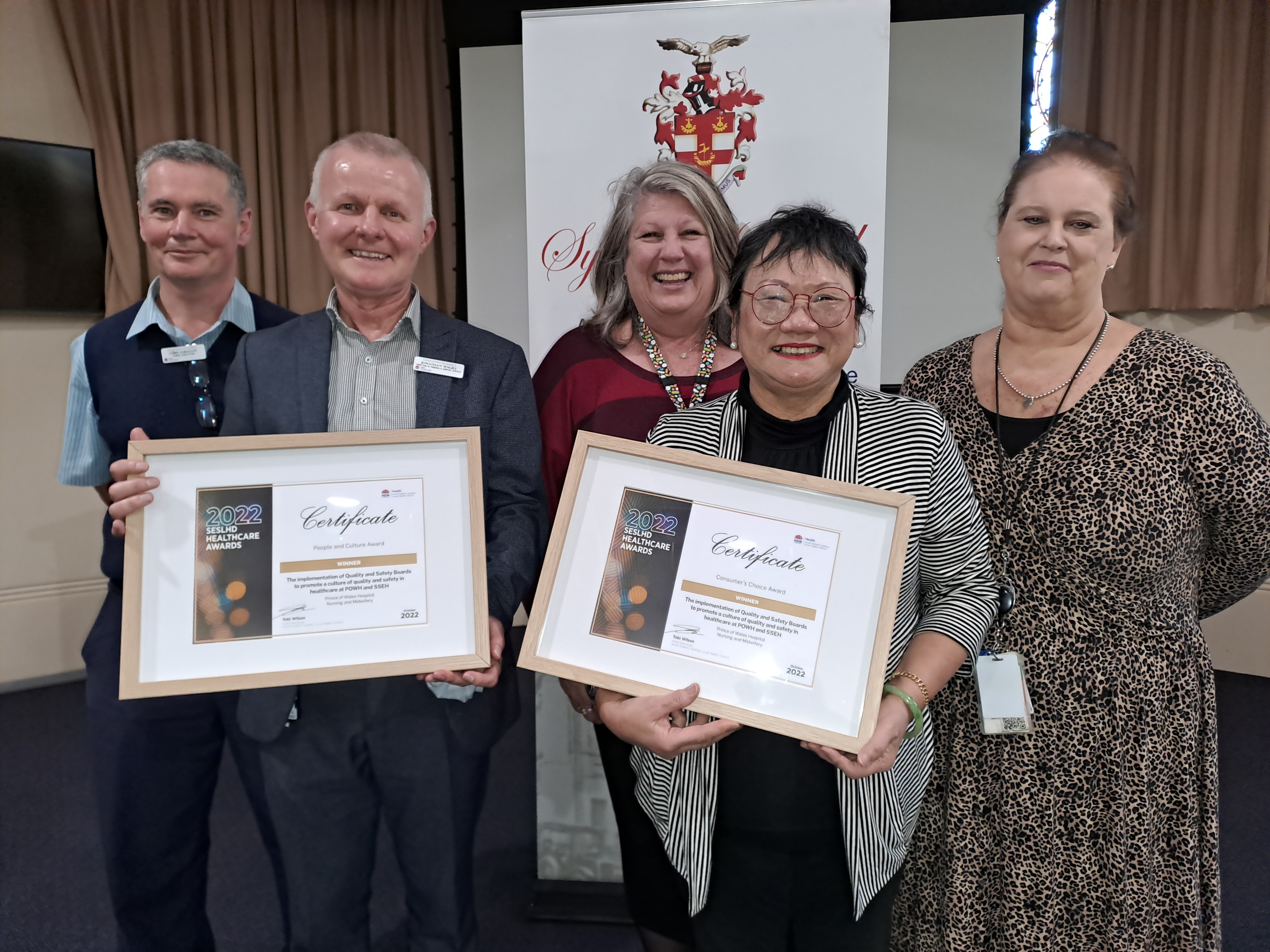
-
The introduction of Quality and Safety Boards (QSB) at POWH and SSEH in 2020 and 2021 respectively, were designed to take a consistent approach to quality and safety across the hospitals.
-
36 QSBs were installed across clinical units at POWH and 9 boards installed across SSEH. The QSBs have been designed to be used in a day to day approach to quality improvement and patient safety.The visual way in which data is displayed on the QSBs enables data to be easily understood and interpreted for both clinical staff and patients.
-
The QSBs are located in all clinical areas and the data displayed on the boards is unique to that clinical area. This information is based on clinical risks, hand hygiene performance, audit data, quality improvement and patient/consumer feedback and staff/team recognition.
-
QSBs support effective clinical governance, leadership and the local safety and quality culture within the multidisciplinary team. The data displayed offers transparency about the standard of care delivered by the healthcare team.
-
The QSBs can be incorporated into clinical discussion around quality and safety and can be paired with other communication tools such as Safety Huddles, Team meetings, staff education, leadership walk rounds to promote quality and safety at all levels of the organisation
-
The QSBs have also been adopted at Executive level and are tabled at monthly POWH/SSEH Clinical Council, Senior Managers Governance Committee and Consumer Partnership Committee meetings.
-------------------------------------------------------------------------------------------------------------------------------------------------------
Highly Commended
POWH Emerging NUM Project 2019 – current – POWH
The Emerging NUM (ENUM) program at Prince of Wales Hospital and Sydney/Sydney Eye Hospital aimed to develop a comprehensive skilled cohort of leaders and uses a person-centred multifaceted approach intended to support the development of nurses in their leadership journey. The ENUM program is now in its third year and has been very successful, seeing all applicants from POWH having had a leadership opportunity as a result of the program, either as a secondment or a permanent role.
Quality clinical leadership is required for the development of effective high performing teams and a cultu·re of safety. Nursing Unit Managers (NUMs) are front line leaders required to manage complex dynamic situations and create environments which support and enable staff to achieve professional, high standards of patient care. The NUM requires organisational support to develop a wide range of skills and support networks; leadership; engagement of staff; create innovative change; develop themselves and to enable care delivered with warmth, empathy and compassion. Leadership which creates a positive workplace culture is positively linked to good patient and staff outcomes. Investing in future leaders who have demonstrated leadership potential and commitment through past performance is important for our Organisation.
Winner
The Lithotomy Challenge - Promoting upright birth positions and reducing the use of lithotomy and semi-recombinant positions in birth to improve women’s outcomes – TSH
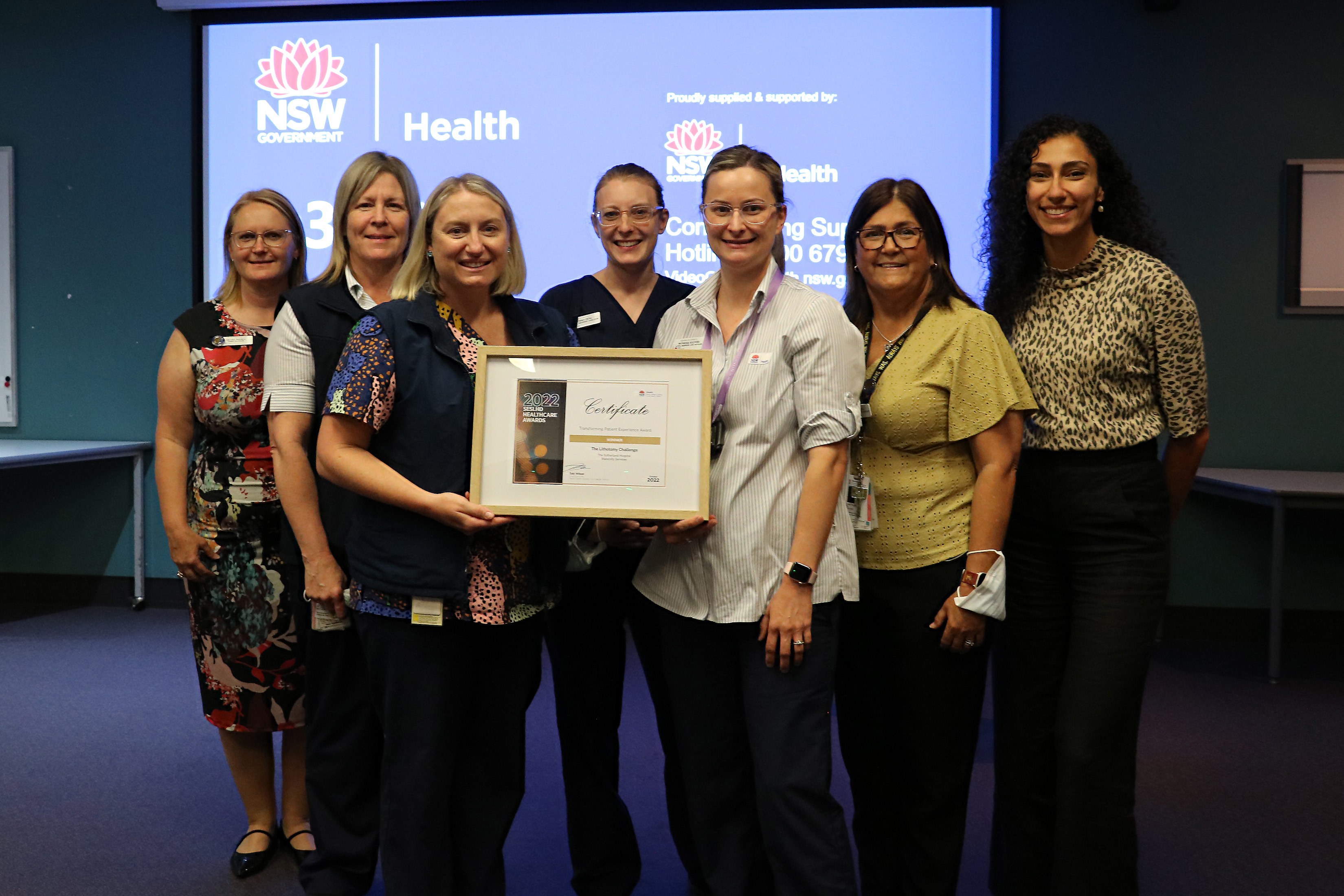
AIM: To reduce the rate of third degree perineal tears from 2.8% to 2.0% in the TSH delivery suite by December 2021.
BACKGROUND: In 2021, TSH experienced a higher than normal HAC of 3rd degree perineal tears, totalling nine in May alone. Analysis of these vaginal births identified two common themes, birth position, (semi-recumbent or lithotomy) and a high rate of episiotomies.
An extensive literature research of the impact of maternal positions in second stage labour revealed upright birth positions can reduce severity of perineal trauma, instrumental births, duration of 2nd stage of labour and episiotomies.
METHOD
- Simulated “birth drills” with midwifery and medical staff highlighting the challenges and psychological impact of the vulnerability of the lithotomy position
- Development and display of an upright birth position poster for women in labour in the antenatal clinic and delivery suite rooms
- Midwifery champions and monitoring of use of upright birth positions with monthly celebration of success
RESULTS
- Significant reduction in the lithotomy rate and the semi recumbent rate per month.
- Severe perineal tear rate reduced from 2.8% to 2.0%
Education of staff and women empowered them, enabling informed shared decision making whilst partnering with them to manage their own birth plan.
-------------------------------------------------------------------------------------------------------------------------------------------------------
Delivering Antenatal appointments virtually – RHW
Due to COVID-19, RHW Maternity Outpatients initiated virtual antenatal booking appointments to minimise risk of transmission. The appointment is conducted by a midwife using myVirtualCare, a NSW Health supported videoconferencing platform.
The aim was to improve women's experience enabling presence of a support person for the booking (as hospital restrictions were introduced), to reduce travel and time spent away from parenting or work commitments.
Initially, these comprehensive bookings were completed via telephone, whilst an efficient process for videoconferencing was established. With support from the SESLHD Telehealth team, webcams and headsets were acquired and Pexip was introduced. The final phase saw the implementation of the myVirtualCare platform improving efficiency for outpatient clinics due to its waiting room function.
The use of myVirtualCare has helped the midwives build rapport, similar to in-person, whilst convenient and a positive experience for women.
Providing choice for person-centred care is essential and the option to attend an in-person appointment can be accommodated if requested and/or complex issues are identified. This includes women requiring interpreters, ensuring equity of access to improve healthcare.
Use of myVirtualCare delivered benefits during Covid-19, and has demonstrated that this is a sustainable option for antenatal booking appointments in the future.
WMH Integrated Rehabilitation for Early Dementia (iREAD) Program - a machination by the Multidisciplinary Management of Dementia (MOD) Squad – WMH
A stakeholder forum held at WMH in November 2018 as part of the WMH Clinical Strategic Planning, identified the need for a co- ordinated and anticipatory approach to dementia care in the local community, a gap also demonstrated in international literature. In January 2020, the Management of Dementia (MOD) Squad was formed. The MOD Squad's common goal was to harness the geriatric rehabilitation expertise of the WM H's MDT in order to create an integrated rehabilitation program for people with early dementia and their carer. Together they created the integrated rehabilitation for early dementia (iREADi) program.
iREADi's three parallel components consist of:
- A 9-week small group dementia rehabilitation education course with topics provided by members of the MOD Squad
- The iREADi Course facilitates the gradual development of peer and carer relationships in a supportive environment
- Individual goal-based rehab therapy is provided using cognitive rehabilitation exercises and the allocation of a MOD Squad clinician, as 'goal coordinator', to each dyad to facilitate goal setting and attainment.
Outcome measures including social connections, knowledge, skills, self-efficacy, confidence, life quality, emotional/psychological wellbeing and goal achievement were completed prior to and at the end of the iREADi Course (known as Phase 1 of the Program) and again at completion of the Goal Attainment Phase (Known as Phase 2). Results have been overwhelmingly positive, demonstrating effectiveness in filling the gap in the early dementia post diagnosis support pathway in SESLHD. During the darkest days of Sydney's Covid-19 lockdowns, the iREADi Program has successfully transformed post diagnostic experience and life quality of 71 participants between mid-2020 until now (numbers impacted by Covid-19).
Winner
Dr Kristen Overton – POWH
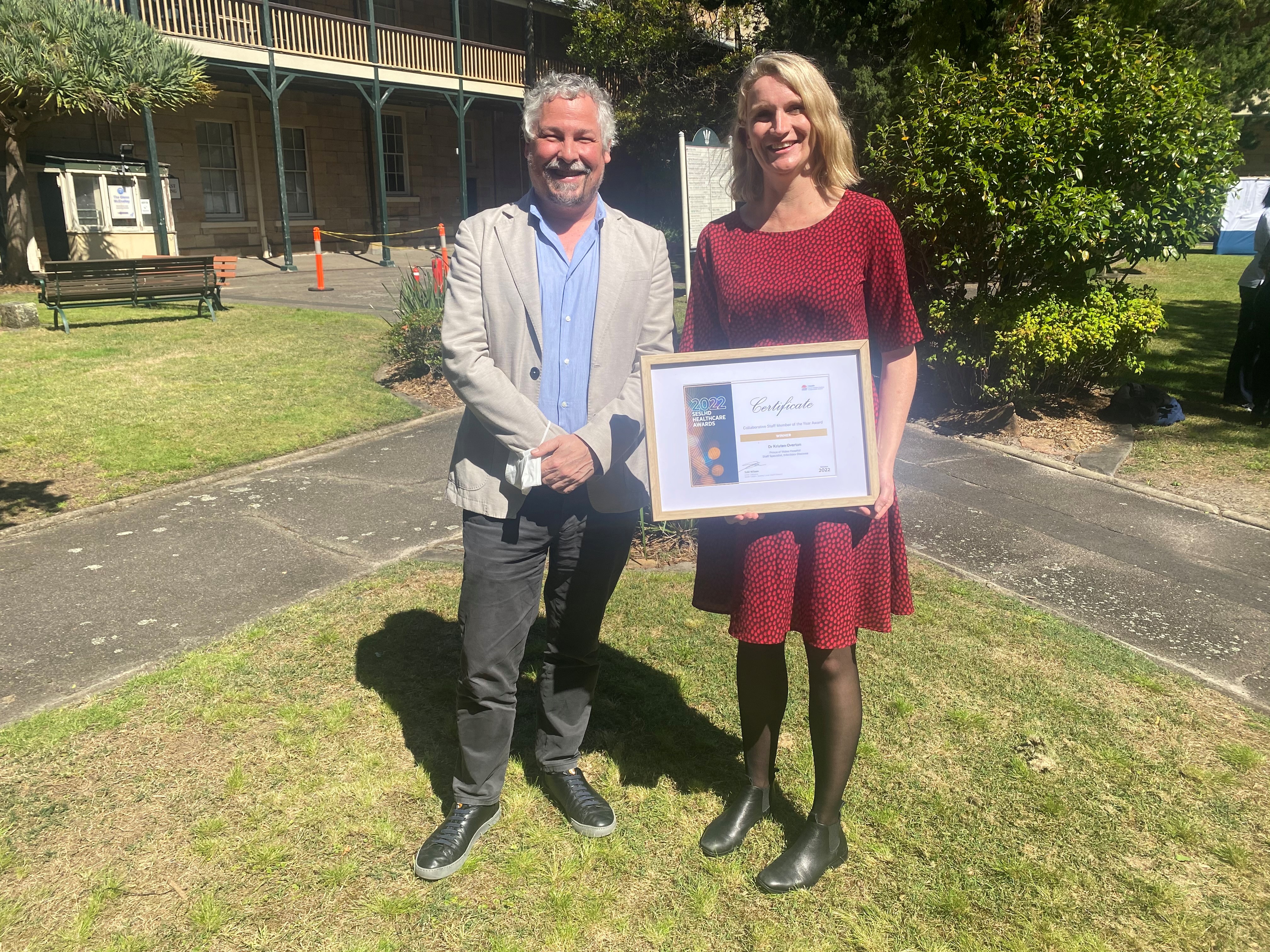
Dr Kristen Overton, a Staff Specialist in Infectious Diseases (ID) at POWH, was instrumental in her leadership of the SESLHD COVID-19 Community Management Centre (CMC), supporting thousands of COVID positive patients to remain safely at home. Kristen led with courage and confidence in decision making during times of intense pressure. She saw the service as a whole, understanding the critical role every team - admin, clinical and remote monitoring (RMS) - played in delivering safe care and supported the teams to work together. She ensured all staff deployed to the CMC, especially nursing and allied health staff, were regularly updated and felt supported in their roles despite the constantly changing environment.
-------------------------------------------------------------------------------------------------------------------------------------------------------
Dr Antonia Shand – RHW
Antonia works tirelessly to keep the maternal fetal medicine (MFM) department running. She provides excellent clinical care to women with high risk pregnancies. Some of the women she cares for are experiencing a loss of a baby, or finding out the baby has a problem, and she goes above and beyond to emotionally support the whole family. She works collaboratively with many teams, and midwives in MFM and perinatal loss. She supports education and research for everyone who expresses interest. She is a wonderful leader and we are in awe of all the things she can accomplish in a day.
Rajan Manickarajah – PaCH
Rajan Manickarajah is an innovative, dedicated, passionate, and solution focused staff member. Since the beginning of the COVID-19 pandemic, he has provided high-level information systems support and actively collaborated with MHCS and Ministry of Health (MoH) COVID-19 Communication Team to provide high quality in-language resources for culturally and linguistically diverse (CALD) communities. He has actively supported PaCH services and SESLHD Executive in relation to online webinars and the development of audio-visual resources. Rajan has worked in partnership with Local Health Districts, Cancer Institute NSW, Multicultural NSW, and Department of Customer Service to improve communication to CALD communities across NSW.
Samantha Gifford – STG
Samantha has excellent knowledge, skills and expertise in her role as the Aboriginal Hospital Liaison Officer. She covers St George and Sutherland Hospitals and is working towards developing champions in Aboriginal health to assist in the delivery of her important work.Sam is part of the St George Diversity Health Team and plays an important role in the promotion of providing culturally competent care and equal access to services for all people.The patients and families that Sam works with benefit tremendously from her dedication and passion.
Prof Ken Butcher – POWH
As the Medical Director of the NSW Telestroke Service, hosted at POWH, SESLHD, Professor Butcher is the lead clinical collaborator working with the Ministry of Health, the Agency for Clinical Innovation and eHealth NSW to implement and sustain the Statewide Service. Professor Butcher’s leadership as an expert in best-practice stroke management, has inspired positive cultural change across Regional and Remote NSW to facilitate improved patient access to hyperacute stroke care.
Winner
Doug, Wendi and Roxy Murray – STG
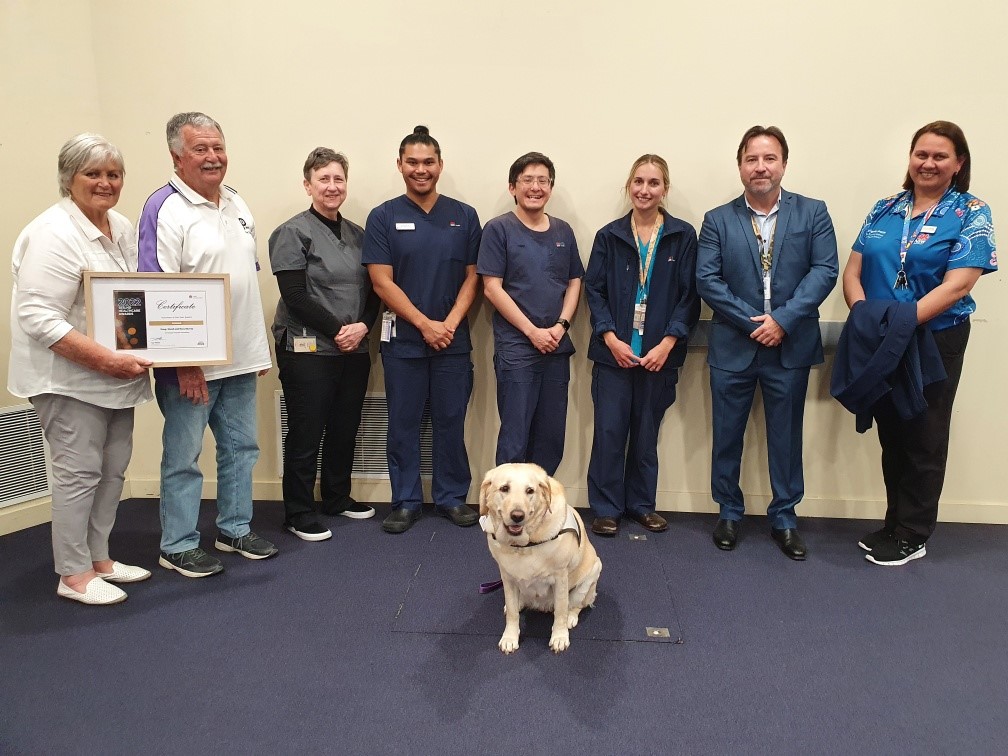
Wendi and Doug generously volunteer their time each week by bringing Roxy, their Pet Therapy dog to St George Hospital, with the intention of providing cheer and emotional support for patients, families, carers, and staff alike.
They generously and enthusiastically donate their time to help make St George Hospital a more comforting and less intimidating environment for patients, while also bringing a sense of wellbeing to many of the staff. Wendi, Doug and Roxy light up the faces of every person they encounter during their hospital visits – with everyone always stopping to greet them and have a comforting interaction, as they are always so warm and engaging.
